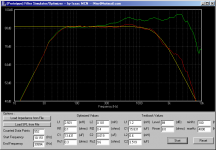Do passive crossovers work well without impedance equalisation? Im building a 3-way floorstander. As an ecomonic constraint i ll be using first order network with good quality components available locally. I wud like to know more abt flattening the impedance curve. Any resource?
Thanks...
Thanks...
It is not essential to flatten the impedence curve. It is good if you know what the actual value of the impedence is at the frequency you want to put the crossover as the impedence is seldom what the nominal impedence of the driver is supposed to be. If you know the value you can get good results by looking up the usual tables. The area I would be a bit concerned about is the high pass filter that feeds the tweeter. If the frequency you want to use is too near the tweeter resonance you can have problems. If you can afford to use one extra coil(inductor) I think there is a lot to be said for making that part a 12 db/octave cross over. If you do that then the inductor placed across the tweeter will help reduce the effects of the resonance peak. It also increases powerhandling and I think it makes the tweeter sound a bit cleaner. (But I know those who only like first order systems won't agree with that.)
As to resources about flatterning the impedence curve there are few things that you can do. The simplest one is to compensate for the rise in impedence which comes from the inductance of the voice coil. You correct that by measuring the DC resistance of the coil and then if you know the inductance of the voice coil you put a "zobel network" across the speaker terminals. This is made up of a resistor equal to the DC resistance of the voice coil in series with a capacitor. The value of the capacitor is chosen so that as the frequency rises the impedence of the capacitor falls and compensates for the way the impedence of the voice coil rises. It is a bit harder to compensate for the resonance peak that the drivers have. This usually requires a LCR network across the speaker. But if you are going to try and do this you are starting to spend fair bit of money that could go into a network with steeper slopes. I mean if you fully compensate a midrange or a tweeter then you will use five components on each unit and that seems to cancel out the money you save with a first order network.
With a bit of tweaking, yes they can work well. While flattening the impedance curve does allow a textbook filter to function like, well, a textbook electrical filter, taming the acoustic response of the particular driver still needs to be done. A textbook electrical filter doesn't necessarily give you a textbook acoustic filter.
Take for example the case pictured below. The textbook response is of the 4th-order type transfer function, but as you can see the computer optimized filter is practically of the 2nd-order type only... Xx2 parts may be omitted and the optimized response is realized even without impedance compensation.
For more information about impedance compensation networks, grab any good university-grade book about circuit analysis and/or some of these books.
Cheers
Take for example the case pictured below. The textbook response is of the 4th-order type transfer function, but as you can see the computer optimized filter is practically of the 2nd-order type only... Xx2 parts may be omitted and the optimized response is realized even without impedance compensation.
For more information about impedance compensation networks, grab any good university-grade book about circuit analysis and/or some of these books.
Cheers
Attachments
Hi all...Thanks for u r replies..i have already ordered 3 books from U.S.A., namely Loudspeaker design Cookbook by Vance Dickason, Introduction to Loudspeaker design by J.L. Murphy and Testing Loudspeakers by Joe D'Apollito.
I have a free download from www.trueaudio.com and crossover calculators from www.ajdesigner.com.
I have a free download from www.trueaudio.com and crossover calculators from www.ajdesigner.com.
Bill,
It's a tiny program I wrote to test some ideas about Crossover Simulator's (future) filter optimizer. The new Subwoofer Simulator is just waiting for its user-interface to be finalized, but before I proceed, I'd like to see what I can do with XoverSim... I'm thinking of finally combining the two programs into one speaker simulator. At the moment, I'm trying to write XoverSim's graphical schematics editor.
So much to do So little time
So little time 
Cheers
It's a tiny program I wrote to test some ideas about Crossover Simulator's (future) filter optimizer. The new Subwoofer Simulator is just waiting for its user-interface to be finalized, but before I proceed, I'd like to see what I can do with XoverSim... I'm thinking of finally combining the two programs into one speaker simulator. At the moment, I'm trying to write XoverSim's graphical schematics editor.
So much to do
 So little time
So little time 
Cheers
- Status
- This old topic is closed. If you want to reopen this topic, contact a moderator using the "Report Post" button.
- Home
- Loudspeakers
- Multi-Way
- Some basics abt passive crossovers.
